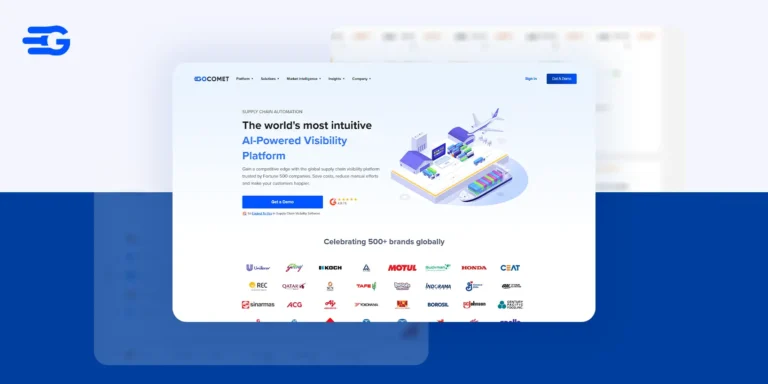3PL Inventory Management: What It is, Services, Benefits & Companies
The COVID-19 pandemic has exposed the vulnerabilities and inefficiencies of many supply chains around the world. From shortages of essential goods to delays in deliveries, businesses have faced unprecedented challenges in meeting customer demand and maintaining profitability. To cope with these disruptions and uncertainties, many e-commerce businesses have turned to third-party logistics (3PL) providers to manage their inventory and other aspects of their logistics operations.
But what exactly is 3PL inventory management and how can it benefit your ecommerce business? In this article, we will explain the concept, the services, and the advantages of 3PL inventory management. We will also share some tips on how to choose the right 3PL provider for your business and showcase some successful case studies of 3PL partnerships.
Introduction to 3PL Inventory Management
Defining 3PL Inventory Management
3PL or third-party logistics refers to specialized firms that handle various supply chain functions like warehousing, shipping, fulfillment etc. for other companies. 3PL inventory management outsourcing is an arrangement where a manufacturer engages an external expert logistics provider to optimize, track and manage inventory across the supply chain cycle.
The Evolution of 3PL in Supply Chains
Initially, 3PLs were mere alternatives to costly in-house logistics departments focusing only on basic warehousing and shipping services. But with increasing globalization and complexities of modern supply chains, 3PLs have transformed into sophisticated IT-based solutions providers delivering end-to-end transparency and efficiency across the entire product flow continuum.
Today’s top 3PLs deploy advanced predictive analytics, IoT sensors, and AI to enable real-time visibility and interactive collaboration across supply chain nodes. From raw material vendors to the end-consumer, they help connect the dots to create lean, agile and demand-driven supply chains.
Key Services of 3PL Providers
Modern 3PLs deliver far beyond just holding and transporting inventory. Let’s look at some of their offerings in detail:
Warehousing and Distribution
Warehousing and distribution are the core functions of 3PL inventory management. They involve storing, handling, and moving goods from one location to another, within or across borders. 3PL providers typically own or operate multiple warehouses and distribution centers, strategically located near major markets, ports, or transportation hubs, to ensure optimal accessibility and coverage.
Order Fulfillment and Shipping
Order fulfillment and shipping are the critical functions of 3PL inventory management. They involve processing, picking, packing, and delivering orders to customers, either directly or through intermediaries. 3PL providers typically offer various order fulfillment and shipping options, such as standard, express, same-day, or next-day delivery, as well as reverse logistics, such as returns, exchanges, or repairs.
Technology Integration in 3PL
Technology integration is the enabling function of 3PL inventory management. It involves using various digital tools and systems to facilitate and automate the inventory management processes, such as inventory tracking, forecasting, replenishment, allocation, and optimization. 3PL providers typically use advanced technology solutions, such as barcode scanners, RFID tags, GPS trackers, ERP systems, WMS systems, TMS systems, and more.
Benefits of Outsourcing Inventory Management to 3PLs
Outsourcing inventory management to 3PLs can bring significant benefits to businesses, regardless of their size, industry, or location. Some of the most notable benefits are:
Cost Efficiency and Flexibility
3PLs drive significant cost savings over in-house operations through warehouse and transport synergies, economies of scale, and minimal fixed asset investment for manufacturers. Their specialized infrastructure also allows better adaptability to demand fluctuations through on-demand overflow capacities.
Companies can better align capital expenses to core competencies like production or R&D. 3PLs also facilitate faster launch of products or entry into new markets riding on their established networks.
Enhanced Visibility and Efficiency
Get end-to-end inventory visibility across every node whether a warehouse, transhipment hub or storefront for proactive stock monitoring and rebalancing. Data-driven analytics provides clarity into days of supply metrics, stock keeping unit rationalization opportunities and working capital optimization levers rooted in inventory management.
Overall cycle times can be improved by up to 30% through enhanced coordination of order-to-cash steps like sourcing, production planning, storage, transport and delivery.
Scalability and Global Expertise
Quickly scale distribution network, add new product lines or expand to international markets by leveraging 3PLs’ global infrastructure and proven expertise without own fixed investments. Focus resources on high-value functions like customer acquisition and product innovation.
3Pls maintain existing high service standards as volumes fluctuate without expensive in-house infrastructure addons. They also help navigate complexity of local compliance and customs regulations in international markets through experience.
Choosing the Right 3PL Provider
With so many 3PL vendors promising the moon, selecting the ideal inventory management partner is crucial based on strategic needs and capabilities mapping.
Criteria for Selecting a 3PL Partner
Outsourcing inventory management to 3PLs can bring many benefits to businesses, but it also requires careful consideration and evaluation. Not all 3PL providers are the same, and choosing the wrong one can result in poor service quality, customer dissatisfaction, or even legal issues. Therefore, businesses need to choose the right 3PL partner for their inventory management needs, based on the following criteria:
- Service scope and quality: Businesses need to assess the service scope and quality of the 3PL providers, such as the types, levels, and options of inventory management services they offer, the locations, capacities, and conditions of their facilities and equipment, the standards, certifications, and accreditations they have, and the performance, reliability, and responsiveness they demonstrate.
- Technology capability and compatibility: Businesses need to evaluate the technology capability and compatibility of the 3PL providers, such as the types, features, and functionalities of the technology solutions they use, the integration, interoperability, and security of their technology platforms and systems, the availability, accessibility, and usability of their technology tools and interfaces, and the innovation, scalability, and flexibility they exhibit.
- Cost structure and value: Businesses need to compare the cost structure and value of the 3PL providers, such as the pricing, fees, and charges of their inventory management services, the terms, conditions, and contracts of their service agreements, the incentives, discounts, and benefits they offer, and the return on investment, savings, and profitability they deliver.
- Relationship fit and trust: Businesses need to determine the relationship fit and trust of the 3PL providers, such as the alignment, compatibility, and complementarity of their goals, values, and cultures, the communication, collaboration, and coordination of their teams, processes, and strategies, the feedback, reviews, and references they receive, and the reputation, credibility, and loyalty they possess.
Case Studies of Successful 3PL Partnerships
To illustrate the benefits and criteria of choosing the right 3PL partner for inventory management, here are some examples and case studies of successful 3PL partnerships in different industries and regions:
- Amazon and Kuehne+Nagel: Amazon, the global e-commerce giant, partnered with Kuehne+Nagel, one of the world’s leading 3PL providers, to manage its inventory and distribution in Europe. Kuehne+Nagel provided Amazon with warehousing, fulfillment, and shipping services, using its extensive network of facilities and carriers, as well as its advanced technology solutions, such as KN Login, a web-based platform that enables real-time visibility and control of inventory and orders. As a result, Amazon was able to increase its customer satisfaction, delivery speed, and market share in Europe, while reducing its operational costs and risks.
- Nike and DHL: Nike, the global sports apparel and footwear brand, partnered with DHL, the world’s largest 3PL provider, to manage its inventory and distribution in Asia. DHL provided Nike with warehousing, fulfillment, and shipping services, using its state-of-the-art facilities and equipment, such as automated storage and retrieval systems, conveyor belts, and robots, as well as its innovative technology solutions, such as DHL SmartSensor, a device that monitors the temperature, humidity, and shock of shipments. As a result, Nike was able to improve its supply chain efficiency, flexibility, and sustainability in Asia, while enhancing its product quality, customer service, and brand image.
- Unilever and Maersk: Unilever, the global consumer goods company, partnered with Maersk, the world’s largest 3PL provider, to manage its inventory and distribution in Africa. Maersk provided Unilever with warehousing, fulfillment, and shipping services, using its comprehensive network of facilities and vessels, as well as its integrated technology solutions, such as TradeLens, a blockchain-based platform that enables secure and transparent data sharing and collaboration among supply chain partners. As a result, Unilever was able to optimize its inventory levels, replenishment cycles, and delivery times in Africa, while reducing its inventory costs, waste, and carbon footprint.
The Future of 3PL in Inventory Management
The warehousing and logistics industry is projected to grow at 6% CAGR globally according to research. With the tremendous growth of omnichannel retail and direct-to-consumer sales models, the importance of flawless inventory management will rise exponentially. This certainly bodes well for increased 3PL penetration going forward.
Emerging economies offer strong growth potential as 3PL adoption has been slower but factors like GST, infra upgrades and retail boom will catalyze outsourcing. Safety stocks reduction through advanced demand sensing and predictive analytics is another frontier.
While selecting the right strategic partner will remain key, manufacturers will look for 3PL vendors providing integrated technology solutions and visibility across the entire supply chain over just operational contracting and cost arbitration alone. Control tower solutions enabling collaborative inventory planning will gain significance.
Conclusion
Inventory management is a vital function of any business that deals with physical goods. However, inventory management can also be a challenging and expensive process, especially for businesses that operate in complex and dynamic environments. That’s why outsourcing inventory management to 3PLs can be a smart and strategic decision, as it can help businesses achieve cost efficiency, flexibility, scalability, expertise, visibility, and more.
However, outsourcing inventory management to 3PLs also requires careful consideration and evaluation, as not all 3PL providers are the same, and choosing the wrong one can result in poor service quality, customer dissatisfaction, or even legal issues. Therefore, businesses need to choose the right 3PL partner for their inventory management needs, based on the criteria of service scope and quality, technology capability and compatibility, cost structure and value, and relationship fit and trust.
The future of 3PL in inventory management is bright and promising, as the global economy, technology, and customer expectations continue to evolve and transform. 3PL providers will continue to offer more and better inventory management services, solutions, and innovations, to meet the diverse and dynamic needs of their clients, and to create more value and differentiation for their businesses






